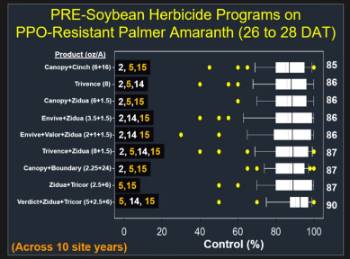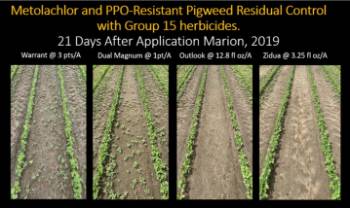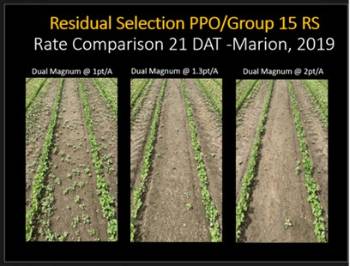Two residuals PRE better than one for soybean!
Two residuals PRE better than one for soybean!
By: Tom Barber, Jason Norsworthy, and Tommy Butts
There were lots of conversations last week about soybean herbicide programs and specifically which herbicides to use at planting before the weeds and crop emerge. Since the 2015 discovery of PPO-resistant Palmer amaranth in Arkansas, our herbicide options for pigweed control have been drastically reduced. By 2017 our recommendations for herbicide selection at planting changed from a Valor- (flumioxazin) or Authority- (sulfentrazone) based system to a metribuzin plus Group 15 (Dual Magnum) system. Ten site-years of data (Figure 1) in fields heavily infested with PPO-resistant pigweed suggested that this mixture was the best approach. Although at the time we didn’t know, now we are confident that pigweed populations at these locations were also resistant to POST HPPD (Group 27)-containing herbicides such as mesotrione (Callisto) and tembotrione (Capreno) and some PRE applied Group 15 herbicides, specifically metolachlor (Dual Magnum) and acetochlor (Warrant).

Figure 1: Multiple-resistant Palmer pigweed control with various herbicide programs applied at planting. All product rates represented are in ounces within parenthesis following the names. Average pigweed control for each treatment is listed on the right side of the figure. These data are presented in a box and whisker plot, where the smaller the box the less variability in control across site-years. Yellow dots represent outliers.
The last 2 years of research at these locations in Crittenden County indicate that herbicides containing dimethenamid (Outlook) and pyroxasulfone (Anthem Maxx, Zidua) work much better on these multiple-resistant pigweed populations that exhibit resistance to metolachlor. These are all Group 15 herbicides but because of the difference in herbicide metabolism in resistant pigweed populations, Anthem Maxx /Zidua and Outlook have consistently worked better from a residual standpoint (Figure 2).
It is also important to point out the appropriate rate of these herbicides. Notice the Outlook rate of 12.8 fluid ounces per acre and Zidua SC rate of 3.25 fluid ounces per acre (Figure 2). This should be the lower end of rates for each of these products for effective pigweed control. In addition, although Dual Magnum did not perform well at 1 pint per acre, when rates were increased on this pigweed population, improved control was observed (Figure 3 below). Keep in mind these pictures are from last year and data can vary based on environmental conditions and rainfall for activation following application.

Looking back at Figure 1, all herbicide combinations that provided 85% control or greater of multiple-resistant pigweed 28 days after planting contain metribuzin, a Group 5 herbicide. Additionally, all but one combination contained Zidua, a Group 15 herbicide.
Talking with producers and consultants across Arkansas, most soybean fields will likely see a mixture of metribuzin and Group 15 at planting this year. This will be especially important from central up through Northeast, Arkansas, especially east of Crowley’s ridge because this area has the most wide-spread PPO-resistant pigweed. Make sure varieties selected are tolerant to metribuzin, otherwise injury may occur especially in high soil pH areas. A list of the metribuzin tolerance of soybean varieties in Arkansas can be found here. We are not sure how widespread the Group 15 (metolachlor) resistance is, but at this time we have only confirmed it in Crittenden County. Regardless of which population you have, as long as you are mixing a Group 15 with at least 6 oz/A (dry) metribuzin (ex., Tricor), approximately 80% or more control can be expected for approximately 3 weeks following activation. It is very important to make a timely POST application once pigweed emerges. In south Arkansas, PPO resistance is not as widespread, but we know that it’s never a bad idea to rotate our chemistry and move away from flumioxazin (Valor) combinations at least on a rotational basis, especially if you are relying on Flexstar (fomesafen) for POST control.

According to preliminary estimates, soybean growers in Arkansas will plant most of their acres in an Xtend soybean. The cutoff date for dicamba applications in Arkansas is May 25th. If you farm east of the ridge in Northeast Arkansas, down to Phillips county, it is doubtful that Flexstar will work POST for pigweed control when they emerge in Xtend soybean. As we get closer to the second week of May, producers with fields containing PPO-resistant pigweed should switch to either an Enlist, LLGT27, or LibertyLink variety that allows POST alternatives for pigweed control such as Enlist One or Liberty. It is also important to start CLEAN! I have had several calls this week wondering if I have seen pigweed emerge. Be prepared, they are up in some areas! From this point forward, unless the field has been tilled immediately prior to planting, Gramoxone, approved dicamba in Xtend (Engenia, Fexapan, Xtendimax, Tavium) or Enlist One in Enlist soybean should be applied with the PRE herbicide residual mixture. Be sure to check individual herbicide product websites for approved tank-mix options. Wishing everyone a safe and healthy planting season. Call us with questions.
If you would like to read journal article publications from this research click here for management of PPO-resistant pigweed and here for discovery of Group 15 resistance in Arkansas.